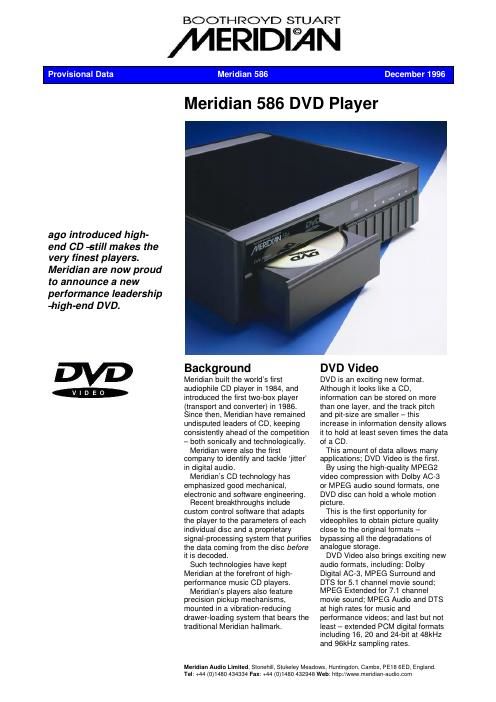Page 1
Provisional DataMeridian 586December 1996Registered trademarks: THX and THX Cinema Lucasfilm Ltd; Dolby, Pro Logic Dolby Digitaland AC-3 Dolby Laboratories Licensing Corporation; Ambisonic
Nimbus Records Ltd; Meridian, Boothroyd Stuart Meridian LipSyncand Meridian Digital Theatre Meridian Audio Ltd; DTS Digital Theatre Systems Inc.; DVD
Toshiba and the Ten Companies; MPEG, MPEG Surround, MPEG2 and MPEG Audio MPEG Organisation; Macrovision Macrovision Inc. High-End DVD?
Through the lifetime of CD, Meridian
have been able to build the best
players - that consistently provided
better sound with each successive
generation of hardware, and with
continually improving disc recording
and mastering techniques.
Important milestones were the
identification and near-eradication of
player design problems including
jitter, mechanical feedback, servo
instability, playability, converter
linearity and interface design.
Bob Stuart, Meridians chief
designer and Chairman of the
Acoustic Renaissance for Audio, has
been heavily involved in the evolution
of the audio formats for DVD -
working hard to ensure that DVD has
the very best potential to serve
audiophiles as well as a mass
market.
It should therefore be no surprise
that Meridians design team brought
the full benefit of their CD experience
to DVD.
But there is more: Meridian also
brought important psychoacoustic
and psycho-visual insights to this
design. As a result, Meridians 586 is
able to offer sound and picture quality
that is second to none - and it offers
the kind of features needed to exploit
DVD in a high-end home theatre and
to interface with state-of-the-art digital
surround processors (like the
Meridian 565) and display systems.
More about the picture
The pictures on DVD Video are stored
using a very high quality compression
system called MPEG2. MPEG2 has a
flexible data rate; this allows more
data to be used for some scenes than
others. So, complex motions and
textures can be conveyed accurately
in the NTSC or PAL video formats,
without using an unnecessarily high
data-rate on simpler material.
Consequently, the encoders (that
make MPEG2 streams from theoriginal film) will be able to improve
continually over the years - a
situation somewhat analagous to CD,
where recording equipment has
steadily improved.
Because the picture is stored as
digital video, it has some remarkable
qualities - including low noise, very
low frame and line jitter and the
potential for deeply saturated colours.
Meridians 586 uses their own
proprietary studio-grade video
processing to provide the very highest
quality video in RGB, Component, S
and Composite formats.
The picture is also much improved
by extensive de-jittering of the DVD
replay system.
All players offer 4:3 and 16:9 aspect
ratios and Letterbox/Panscan.
Versions for NTSC and PAL.
Meridian 586
The 586 is a powerful statement by
Meridian on the potential quality of
the new DVD medium.
A precision dual-lens (for CD or
DVD) pickup mechanism is mounted
in a new version of the unique
Meridian drawer-loading system.
This loader combines the user
benefits of tray-loading with the
extremely important performance
benefits of top-loading. The
mechanism uses a special low-mass
carbon and glass fibre anti-vibration
disc clamp similar to those fitted to
the 500-Series CD players.
Great care has been taken with the
mechanical properties of the disc
transport mechanism. Similarly, the
586 uses a number of special power
supplies, separated on the 4-layer
PCB according to servo, digital, audio
and video functions - and a precision
master oscillator to keep the jitter low.
All outputs use Meridian processing
and are re-clocked for ultra-low jitter.
The 586 provides multiple video
outputs including Composite, S and -
depending on the regional version -
Component, RGB or SCART.Although it is best thought of as a
DVD Transport, the 586 offers a 2-
channel analogue audio output
(normally encoded in Dolby
Surround) for direct connection to
television receivers, or analogue
surround processors like the Meridian
541.
For home theatre use, the 586
provides IEC1937 digital audio
outputs to convey PCM, AC-3, MPEG
Surround and DTS audio streams to
an outboard digital surround
processor - like 565.
The Meridian 586 is fully compatible
with other components in the
Meridian 500 Series - it includes 500
Comms, and can be operated with a
Meridian System Remote (provided)
and inter-operates as part of a
Meridian Theatre.
CD Compatibility
The 586 plays normal Red-Book
audio CDs, but uses a separate lens
to account for this different optical
requirement.
DVD requires a different colour
laser than CD (the DVD laser is a
visible red, unlike the infrared laser
used for CD).
Because the laser is a different
colour, it is not optimal for reading
normal CDs and is not able to play
recordable CDs.
Meridian recommends that any
serious audiophile should buy or keep
a Red Book CD player (like the
superb highly developed 508) and
treat DVD as an entirely separate
format.
Regional Coding
Movie DVDs can be regionally
encoded to prevent distribution of
films outside the region for which they
are approved.
Not all discs will be coded this way,
but each 586 player is coded for one
of the main distribution regions.Specification
System
DVD-Video and CD-DA
Single/double-sided
Single/double layer
Image
NTSC or PAL (according to region)
Letterbox/Panscan
4:3 and 16:9 aspect ratiosVideo Outputs
Composite
S-video
Component (USA and Japan)
RGB on SCART (Europe)
Macrovision copy protection
Conversion and processing to
studio standardsAudio Outputs
2-channel Lt/Rt encoded Dolby
Surround analogue
On-board decoding for 2-channel
AC-3 or MPEG (by region)
Digital outputs for connection to
external decoder (cable and
Toslink) to IEC1937

